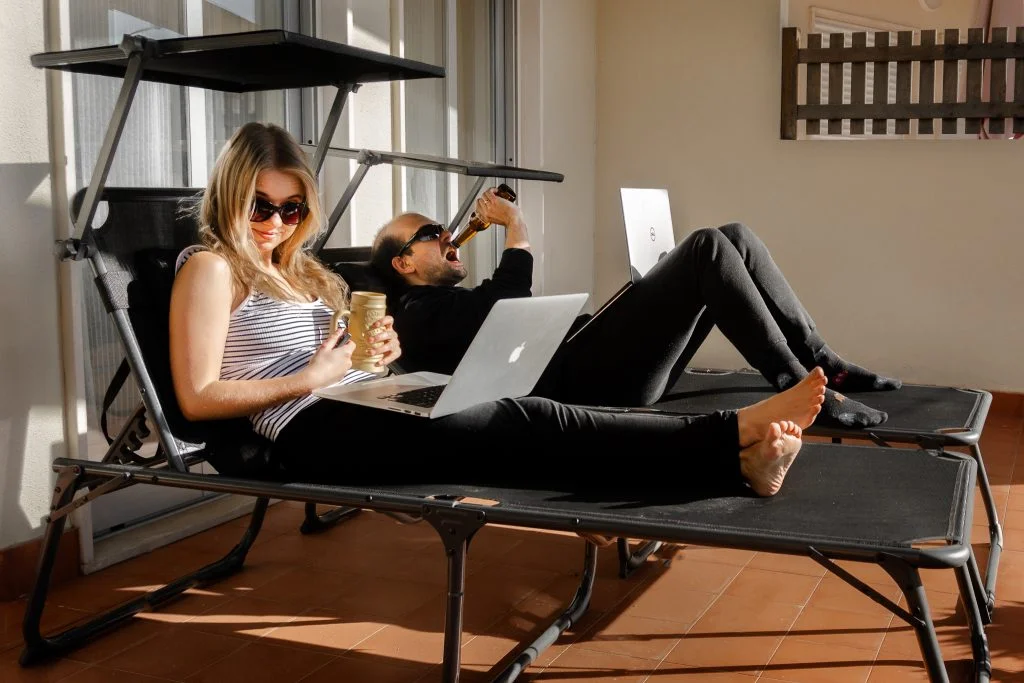Combining slow travels with remote work might seem like a perfect match. But is it really that perfect? In this post, you’ll find out what it really looks like. From our point of view, we’ll share the myths, challenges, pros and cons of taking the work with you on the road. On our example, we’ll also show what slow travel with remote work looks like, and how many drinks on the beach we are drinking while working. 🍹
This website uses affiliate links thanks to which we may earn a commission for purchases you made at no additional cost to you. If you like the content, consider using those links to support us. Thank you!
But first things first – what is slow traveling?
Well, slow traveling is about… slowing down. It means taking more time while traveling and choosing to stay longer in one area. It allows you to immerse yourself fully in the “local experience”.
If I can work remotely from home… Why can’t I work from anywhere?
As for remote work, we can say out loud “Thank you 2020!”. One of the good things that came out of the global pandemic was that it has made remote work more popular than ever. It’s not like remote working wasn’t popular before but now many more people see it as a great life opportunity.
There is a noticeable trend showing that there are more and more remote workers – but not only those who work from home. Also, those who work from anywhere in the world. They call themselves Digital Nomads and you’ve probably heard that term before.
So, can slow travel combined with remote work be a new worldwide trend? We’ll see, but we’re betting yes.

Check out what other travelers have to say about traveling 🗺️
Slow travels with remote work: challenges, myths, pros & cons
Working while traveling is totally different from traveling “vacation style” only. And it is quite surprising for us that many people aren’t aware of that and think it’s a constant vacation with all the time to waste. Yes, it may be possible for some digital nomads, but with “normal 9-5 remote work” it’s just impossible.
So what does it really look like? What are the challenges, myths, pros and cons of slow travels with remote work? Keep reading and find out.
Slow travels with remote work: myths
As mentioned before, many people have misconceptions about what it looks like. Check the most interesting myths we’ve heard ourselves.
Myth number one
The biggest, and most popular one, is the myth about working on a beach with a laptop (best with a cold, alcoholic drink in hand, right?). First of all: have you ever seen what a laptop screen looks like on a sunny day? Or even in a cloudy one but outside and surrounded by sand? How much can you see on the screen in such conditions? Exactly, almost nothing.
The second thing is that laptops don’t like sand. You know… the air vents, various ports, and keyboard would be quite angry about the sand getting in. So our advice is not to take them to the beach and work from a little bit more friendly place like a cafe or something.
Myth number two
We still have people who believe that you can’t combine traveling and working. Or even worse: they think that remote jobs are not jobs, because to work properly you need to be in the office. Of course, there are jobs for which you need to be physically present somewhere but 2020 proved that many things can be done remotely, especially office jobs.
Myth number three
Many people think that this kind of lifestyle is very expensive and people living like that must be soooo rich. Well, slow travel combined with remote working doesn’t have to be that expensive and it’s totally achievable. Of course, it depends on your lifestyle, but in our case, it costs us almost the same as living in Wrocław, Poland. And Poland is considered a cheap country for outsiders, so chances are high that it’s even cheaper for you compared to your earnings in other countries.
You can check out this post for more details: Real Cost Of Living In Spain In 2022

Slow travels with remote work: challenges
Below you can read about some challenges you may have to overcome. We came across them ourselves or heard about them at some point.
Finding a remote job
Finding a completely remote job might be quite challenging. Especially if you’re looking for one “stable 9-5” job. From our observations, many companies which offer remote jobs for some weird reason wish to see their workers from time to time in the office or only allow them to work remotely from certain countries. But don’t worry – it may be hard but not impossible (B2B contracts are the way to go in most cases). It’s much easier with freelance because no one really cares where you are. Although then the problem begins with finding the right number of orders that will pay for travels.
Getting rid of things
The second challenge that you’ll come across is that you’ll need to get rid of most of your things or find a place to store them. By the way, it’s very interesting how little things a person actually needs in life – and travels verify this even more.
Working with let’s-not-work temptations
Another challenge is to stay in one place and work when the weather is nice and the whole world is waiting to be discovered. Temptations, temptations… They are especially strong when being a freelancer and don’t have fixed working hours. Here self-discipline, work routine and good organization will be your best friends. Without them it would be really difficult to sit in front of the computer for a few hours and work. And we guess that you don’t want to quickly bury yourself in overdue projects and unhappy clients, right?
Overworking when you can see the world
On the other side of the coin is overworking. You can quite easily work too much when there are no boundaries between work and home. You need to set limits for how much you work and know when to call it a day. Remember that there are so many beautiful places to see nearby…
It’s not a vacation
You’ll probably visit a lot fewer places than you would on holidays. After all, you need to work, right? Some don’t have the comfort of freely choosing the work schedule, especially during the weekdays. But hey, weekends and free days are all at your disposal for sightseeing so not all is lost.
Finding the right place to stay
Another challenge digital nomads and slowmads need to face is finding a suitable place to stay in. It isn’t as easy as it might look like (at least for us). The bare minimum from our point of view is a good Internet connection and a bearable place to work and rest. And of course, it must be within financial reach.
Changes in daily routine
Often changes in daily routine can be quite annoying too. It changes a little with each new place, but it’s even more noticeable in new time zones (especially while working fixed hours).
Limit chances for faux pas
It’s good to learn about the culture and customs of the country you’re about to visit so you won’t make any faux pas (behavioral gaffe, some type of social mistake). You could be surprised how easy it can be. For example, do you know that in some cultures pointing with your finger, giving thumbs up, or making a peace sign can be considered very rude?
A limited number of things
Also, some people might not be happy about the limitations of things that can be brought with them. For example, those who work on a few monitors probably won’t be able to take them and will have to “endure” working on a laptop. While traveling it’s definitely best to have only a minimal amount of the necessary things.
Determine the cost of living
The last challenging thing that comes to our mind is determining the cost of living in the place you want to work remotely. Until you get there you don’t really know what to expect. Will it be cheap? Or will it be expensive for me? From our experience, pages like numbeo.com are very inaccurate and give much higher numbers. That doesn’t mean that it would be the same or may even be the opposite for you, so we recommend taking these numbers with a grain of salt.

Slow travels with remote work: pros & cons
Slow travels with remote work are not only a fairy tale. Like everything else in the world, it has its own pros and cons. For us, it looks like this (at least for now).
Pros
- Discovering the world not only during the holidays but “in the worst scenario” only during weekends
- Working from everywhere, where you would like to (within common sense, of course)
- Getting to know the culture of the country thoroughly
- No need to live on savings, when you have a constant flow of money
- Breaking the routine and “standard” life
- Developing yourself as a human, get out of your comfort zone, broaden your horizons
- Learning to plan, organize, be agile, and adapt to changing conditions
- Having a better work-life balance, living a slow life without rushing from one vacation/break to another
- No need to spend additional money on a ”typical” vacation – you’re already somewhere nice
Cons
- Dependence on a good internet
- Possibility of staying behind the computer for too long
- Need to be careful about the time spent in each country (tax residency, residency, visas, laws, etc)
- Learning new places, shops every few days/weeks
- Lack of stable routine
Slow travels with remote work: our weekly routine
In our case, the difference between weekdays (working days) and weekends are very noticeable. From Monday to Friday we lead a “normal life” – we’re working, cooking, cleaning, shopping, chilling, watching Netflix, going on a walk, etc. It turns out that there is none or very little time for sightseeing on working days, but sometimes if time permits we also go somewhere close. On the other hand, weekends (and free days) are much more interesting and intensive. Every weekend, if the weather permits, we go sightseeing. We always have a whole list of places we want to visit during our stay in each area, and one by one we cross them out of the list. And then the cycle repeats.
Summing up
Combining slow travel with remote work is associated with many challenges, but it’s also full of many advantages. Is it a perfect combination? For some people yes, for some probably no. For us? It’s amazing. Taking work with us gives us a possibility of constant traveling, and a sense of security that money won’t end and we’ll be forced to stop. For us, it’s the perfect solution.
Oh, one more thing! It’s time to answer the question from the beginning of the post. The amount of drinks we are drinking while working on the beach is… Yhmm… Well… Sorry to disappoint, but… Zero 🍹🤯😂
Want to know more about slow traveling?
You may also be interested in these posts:- Retrospective On The Second Year Of Living As Digital Nomads
- Driving In Europe - Everything You Need To Know
- How to work remotely and travel long-term?
- Best Well-Paid Remote Jobs For Digital Nomads
- Travel Slow Or Travel Fast - Which One Is Better?
- How To Prepare For Full Time Travel As A Digital Nomad?
- Retrospective On The First Year Of Living As Digital Nomads
- 20 Reasons Why You Should Experience Slow Travel
- What Is Slow Travel? - 101 For Beginners







